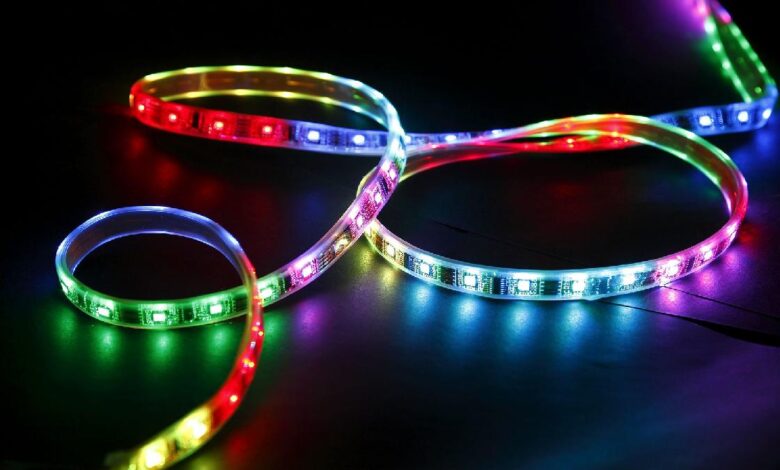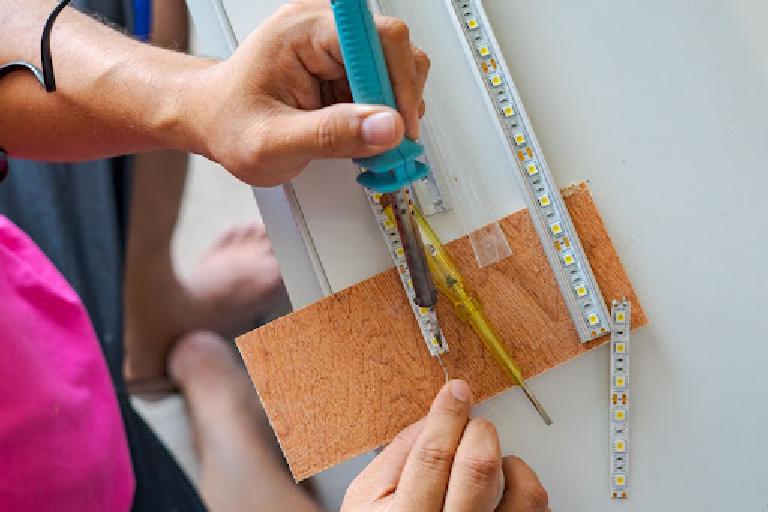Can LED strip lights be used outdoors?

Due to their versatility, LED strip lights have been a very popular source of illumination for at least a few years. Probably the most commonly chosen applications are kitchen LED strip lights and small lighting projects all across the house. But can you use them outdoors? Let’s find out together!
What are LED strip lights exactly?
Before we tackle the main point of this article, let’s take a closer look at the LED tape itself. In essence, a LED strip light is a long circuit board with light-emitting diodes mounted on it in even intervals. All of them are equipped with a self-adhesive backing which can stick to almost any even surface. They commonly come in long reels – you can easily buy LED strip lights that are up to 30 meters long. Thanks to their sequential built, they can be effortlessly cut-to-length – there are designated cut lines between diodes, marked with copper plates. This way you can get the exact length you need without issue – many shops can even pre-cut them for you to bespoke lengths before shipping.
These flexible LED tape lights can be quite easily fitted into tight spaces and corners, which makes them great for e.g., cabinet lighting, drop ceilings and various lighting projects. Plus, they come in many colour options – from standard single colour cool white/warm white, through red, green and blue (and any combination of these three colours), to RGB colour changing LED lights that can be adjusted on the fly.
When it comes to powering your LED strip lighting, there are two types of strips – plug & play and wired. Plug & play ones come with their own transformers (a.k.a. LED driver) and plugs – they are ready to go practically straight out of the box. Wired ones require you to get a dedicated transformer/power supply (same thing, different names) and then connect them through it to the building’s mains – they are typically installed by an experienced electrician.
You can find a wide variety of LED light strips at https://lucasled.ie/led-strip-lights.

Can LED strips be used outdoors?
The short answer is – yes, they can, but not all of them. For LED strip lights (and any other lighting fixtures) to be safely used outdoors, they have to be water- and weatherproof. Non-waterproof strip lights that have no protective coating should be limited to indoor use only. How to know if a light strip is good to go for outdoor use? That’s where Ingress Protection ratings (or IP for short) come into play. Usually, waterproof testing equipment is used to perform the test and get the accurate IP rating for that product.
Ingress Protection ratings
The IP rating tells us about how good a given light source is protected against the elements. It consists of two digits – the first one correlates to protection against solid objects (like sand and dust), while the second one indicates moisture and liquids protection.
There are six levels of protection from solids:
- 0 – No protection;
- 1 – The enclosure can stop objects with a diameter over 50 mm;
- 2 – Stops objects with 12.5 mm and wider diameter;
- 3 – Protection against objects thicker than 2.5 mm;
- 4 – Stops solids thicker than 1 mm;
- 5 – Objects smaller than 1 mm can penetrate the casing, but in quantities small enough not to disturb the fixture’s operation;
- 6 – Complete protection against dust.
When it comes to moisture/liquids, the scale has eight levels:
- 0 – No protection;
- 1 – The fixture won’t be damaged by water drops falling vertically or a water equivalent of 1 mm per minute rainfall;
- 2 – Protection against water drops when tilted at a 15° angle or a 3 mm per minute rainfall;
- 3 – Protected against 60° angled sprays of water;
- 4 – Protection against splashes of water from any direction;
- 5 – The fixture won’t be damaged by jets of water at volume of 12.5 litres per minute and pressure of 30 kPa;
- 6 – Powerful jets of water (100 litres per minute/100 kPa) won’t affect the fixture’s operation;
- 7 – The object can be submerged in water up to 1 meter for at lest 30 minutes;
- 8 – The object can be fully submerged in water below 1 meter (typically up to 3 meters, depending on the manufacturer).
There’s also an additional rating of 9K (protected against strong, high-pressured jets of hot water – 14–16 litres per minute/8–10 MPa/80 °C), but you most probably won’t find it on any LED light strip.
How does it apply in practice? For a general use indoors (including kitchen cabinets above the sink and other damp places) you won’t have to go higher than IP44, while for an outdoor lighting installation you should aim for at least an IP of 64. If you live in a location with heavy rainfalls or intend to place the strip lights near bodies of water, IP65 would be a better choice. Anything above that is rather situational, e.g., if you specifically want to illuminate a pond from below the water level.
LED strip lights and the outdoor temperature
How about the temperature? Well, most of the currently available commercial grade LED strips (especially those with extra coating) can withstand anything that the European weather can throw at them – they have wide range of working temperatures from -30 to +60 °C. But you must keep in mind that this refers to the temperature of individual components and not the ambient air’s temperature. Thus, you should avoid putting them in direct sunlight and on surfaces that can get excessively heated during the day (e.g., metal roofs) or in locations with harsh frosts.

How to mount outdoor LED strip lights?
There are two manners in which outdoor LED strip lights can be mounted – temporary and permanent.
For situational use (e.g., parties or holiday season) you won’t have to fix them permanently. When you intend to bring them out just for short periods, their adhesive backs should be enough to keep them in place. Alternatively, you can use a double-sided adhesive tape or a foam tape. For more firm grip, you can use mounting clips or even a hot glue gun.
If you want to hang your lights permanently, an easy solution for wooden surfaces would be dedicated staples (standard ones are too narrow) or, again, a specialized mounting tape that can stick to uneven surfaces. When mounting on a masonry (e.g., a brick wall), you can utilize clips/hooks and wall plugs plus some drilling to put the lights out there.
LED strip lights – great for both indoor and outdoor lighting
LED chips mounted on a flexible strip can provide task, decorative and ambient lighting for your home and its immediate surroundings. So, LED strip lights are one of the most versatile products that the lighting industry can offer you – they can be put almost anywhere, granted you’ve picked up the ones with sufficient IP rating. Strip lighting also offers various colour temperatures, ranging from warm white similar to candlelight, to cold white that resembles natural daylight. As any other LED lights, they can be easily controlled remotely – you can pick ones that can be dimmed and/or have their light’s colour changed with a simple push of a button. Thus, LED tape lights give you almost limitless options for customization.